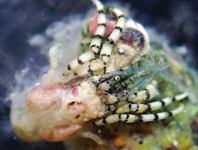Abstract
The names of two cryptic species of Haploembia found in California are resolved and methods for identification are summarized. Molecular data of the Histone III subunit was used to evaluate color and behavior as species identifiers, confirming that antisocial behavior is a good identifier for the parthenogenetic species (Haploembia tarsalis), whereas the more variable coloration patterns were helpful, but less so. A genome size ratio of 1.44 between the parthenogenetic H. tarsalis and the sexually reproducing H. solieri was observed, along with higher genetic variation within the asexual lineage. This, and the identification of what appears to be a putative hybrid, contributes to current work examining mutation rates and selective pressures on genome size in parthenogenetic populations.
References
Alfsnes, K., Leinaas, H.P. & Hessen, D.O. (2017) Genome size in arthropods; different roles of phylogeny, habitat and life history in insects and crustaceans. Ecology and Evolution, 7, 5939–5974.
https://doi.org/10.1002/ece3.3163Arumuganathan, K. & Earle, E.D. (1991) Estimation of nuclear DNA content of plants by flow cytometry. Plant Molecular Biology Reporter, 9, 229–241.
https://doi.org/10.1007/BF02672073Büsse, S., Hörnschemeyer, T., Hohu, K., McMillan, D. & Edgerly, J.S. (2015) The spinning apparatus of webspinners—functional morphology, morphometrics and spinning behavior. Scientific Reports, 5, 9986.
https://doi.org/10.1038/srep09986Colgan, D.J., McLauchlan, A., Wilson, G.D.F., Livingston, S.P., Edgecombe, G.D., Macaranas, J., Cassis, G. & Gray, M.R. (1998) Histone H3 and U2 snRNA DNA sequences and arthropod molecular evolution. Australian Journal of Zoology, 46, 419–437.
https://doi.org/10.1071/ZO98048Dolezel, J., Bartos, J., Voglmayr, H. & Greilhuber, J. (2003) Nuclear DNA content and genome size of trout and human. Cytometry Part A, 51A, 127–128.
Dolezel, J., Greilhuber, J. & Suda, J. (2007) Estimation of nuclear DNA content in plants using flow cytometry. Nature Protocols, 2, 2233–2244.
https://doi.org/10.1038/nprot.2007.310Edgerly, J.S. (1997) Life Beneath Silk Walls: A Review of the Primitively Social Embiidina. In: Choe, J. & Crespi, B. (Eds.), The Evolution of Social Behaviour in Insects and Arachnids. Cambridge University Press, Cambridge, pp. 14–25.
https://doi.org/10.1017/CBO9780511721953.003Edgerly, J.S., Davilla, J.A. & Schoenfeld, N. (2002) Silk spinning behavior and domicile construction in webspinners. Journal of Insect Behavior, 15, 219–242.
https://doi.org/10.1023/A:1015437001089Gregory, T.R. (2002) Genome size and developmental complexity. Genetica, 115, 131–146.
https://doi.org/10.1023/A:1016032400147Hanahan, S.J. & Johnston, J.S. (2011) New genome size estimates of 134 species of arthropods. Chromosome Research, 19, 809–823.
https://doi.org/10.1007/s10577-011-9231-6Henry, L., Schwander, T. & Crespi, B.J. (2012) Deleterious mutation accumulation in asexual Timema stick insects. Molecular Biology and Evolution, 29, 401–408.
https://doi.org/10.1093/molbev/msr237Hodson, A.M., Cook S.E., Edgerly, J.S. & Miller, K.B. (2014) Parthenogenetic and sexual species within the Haploembia solieri species complex (Embioptera: Oligotomidae) found in California. Insect Systematics & Evolution, 45, 93–113.
https://doi.org/10.1163/1876312X-44032095Huelsenbeck, J.P. & Ronquist, F. (2001) MRBAYES: Bayesian inference of phylogenetic trees. Bioinformatics, 17, 754–755.
https://doi.org/10.1093/bioinformatics/17.8.754Korneup, A. & Wanscher, J.H. (1981) Methuen Handbook of Colour. Eyre Metheun, London, 252 pp.
Miller, K.B., Hayashi, C.Y., Whiting, M.F., Svenson, G.J. & Edgerly, J.S. (2012) The phylogeny and classification of Embioptera (Insecta). Systematic Entomology, 37, 550–570.
https://doi.org/10.1111/j.1365-3113.2012.00628.xMorgan-Richards, M., Hills, S.F.K., Biggs P.J. & Trewick S.A. (2016) Sticky genomes: using NGS evidence to test hybrid speciation hypotheses. PLOS One, 11 (5), e0154911.
https://doi.org/10.1371/journal.pone.0154911Rambur, M.P. (1842) Histoire Naturelle des Insectes Neuropteres. Embiides. P. Duménil, Paris, 5 pp. [pp. 310–314]
Ross, E.S. (1960) Parthenogenetic African Embioptera. Wasmann Journal of Biology, 18, 297–304.
Ross, E.S. (1966) The Embioptera of Europe and the Mediterranean region. Bulletin of the British Museum, 17, 272–326.
Ross, E.S. (1984) A synopsis of the Embiidina of the United States. Proceedings of the Entomological Society of Washington, 86, 82–93.
Stamatakis, A. (2006) RAxML-VI-HPC: Maximum likelihood-based phylogenetic analyses with thousands of taxa and mixed models. Bioinformatics, 22, 2688–2690.
https://doi.org/10.1093/bioinformatics/btl446Stefani, R. (1953) La fisiologia dell’accoppiamento in Haploembia solieri Ramburi. Rendiconti Accademia Nazionale dei Lincei, 15, 211–216.
Stefani, R. (1956) Il problema della partenogenesi in Haploembia solieri Ramb. (Embioptera-Oligotomidae). Memorie Accademia Nazionale dei Lincei, 8, 126–201.
Stefani, R. (1959) Aspetti zoogeografici di un problema evolutivo. Bolletino di Zoologia, 26, 105–113.
https://doi.org/10.1080/11250005909439261Stefani, R. (1960a) I rapporti tra parassitosi, sterilita maschile e parthenogenesi accidentale in popolazioni naturali di Haploembia solieri Ramb. anfigonica. Rivista di Parassitologia, 21, 277–287.
Stefani, R. (1960b) La parassitosi da Diplocystis negli embiotteri con particolare riguardo all’azione patogena esercitata dal parassita sull’ospite. Rivista di Parassitologia, 21, 88–127.
Stefani, R. & Contini, C. (1961) Caratteri morfologici distintivi nelle forme anfigonica e partenogenetica di Haploembia solieri. Estratto dalle Memorie della Societa Entomologica Italiana, 40, 36–43.
Whittall, J.B., Liston, A., Gisler, S. & Meinke, R.J. (2000) Detecting nucleotide additivity from direct sequences is a SNAP: an example from Sidalcea (Malvaceae). Plant Biology, 2, 211–217.
https://doi.org/10.1055/s-2000-9106

